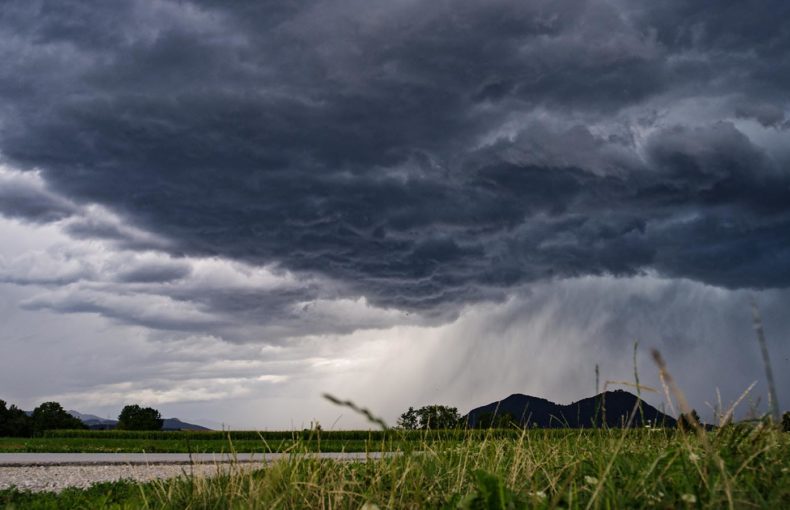How inaccurate weather forecasts cost the global economy billions – and what Spire is doing about it
Written by:
Travis Turgeon
Independent Investigative Writer
Meghan Mussoline
Marketing Content Consultant, Spire Weather and Climate
 Written by
Written bySpire Global
Today, the unpredictable nature of our global climate is more apparent than ever, with brutal heat waves testing our power grids, flash floods destroying towns and businesses, and hurricanes evacuating cities and driving people from their homes.
With the baseline of our climate shifting dangerously fast, the need for more accurate, timely, and reliable weather forecasting has reached unprecedented heights.
Due to the accelerating effects of climate change, the world is experiencing more frequent and extreme weather events, and nearly every industry is looking for strategies to become more resilient. From agriculture to aviation to insurance, the entire global economy is vulnerable to natural disasters, and in some cases, lives and livelihoods are hanging in the balance.
Here at Spire, we recognize the need for a new age of weather forecasting and harness the power of space technology to deliver unmatched solutions. Not only are we poised to redefine how the world collects and utilizes weather data, but we are doing so in ways that will enable people to mitigate operational risks, protect assets, and reduce harm to people and the planet.
Below, we cover how we are changing the weather forecasting landscape, providing insights into global weather challenges and how our technology can help solve them.
The need for more accurate weather forecasting
As climate change accelerates and weather patterns become more volatile, the need for more accurate weather forecasting is clear.
In fact, most of the world’s leading organizations have made this a priority. From NASA to the NOAA, from EUMETSAT to the Met Office, organizations around the world have made statements outlining the severity of the issue, the need for better climate and environmental data, and, ultimately, more accurate weather forecasting.
“As we confront the growing challenges of climate change, it’s crucial that we have robust and consistent methods for managing and sharing data in emerging fields like marine carbon dioxide removal.”
NOAA on the Importance of Environmental Data in Combating Climate Change
“NASA’s Earth-observing satellites provide societally important data and demonstrate transformative applications. The need for more data and better scientific information on Earth’s interacting systems has only increased in urgency in recent years, making investment in the work of NASA’s Earth Science Division (ESD) all the more vital.”
NASA on How Scientific Data Provides Crucial Evidence for the Impacts of Climate Change
“As Europe’s operational satellite agency, EUMETSAT is committed to taking the necessary steps to address climate change and its consequences through cooperative action. The climate data EUMETSAT collects and processes enable experts to better understand climate change and policymakers to mitigate further damage to the planet.”
EUMETSAT on its Commitment to Data-Driven Climate Action
The implications of climate change on weather forecasting
It is no longer deniable: climate change is transforming global weather systems and creating a new, more volatile reality, in which extreme weather events are becoming more frequent, more intense, and more complex to predict. While it’s not the case in every geographic location, average global temperatures are rising, leading to stronger storms, altered rainfall patterns, and shifting seasonal cycles.
Simply put, weather forecasting has become more complex and crucial than ever before.
How climate change affects weather events and seasonal climate
- Rapid Storm Intensification: Hurricanes and tropical cyclones are strengthening at unprecedented rates, leading to heightened states of risk for people, communities, and the natural world. Hurricane Milton, which made landfall in Florida in October 2024, is a prime example of how storms now intensify at record speeds. In just 49 hours, it developed into a Category 5 hurricane, with wind speeds increasing from 35 mph to 160 mph during that time. This kind of rapid intensification challenges traditional forecasting methods, especially those trained on historical patterns that no longer reflect the extreme storm behavior we’re seeing today.
- Unpredictable Rainfall Patterns: Areas that were once unaffected by heavy rainfall and drought are now seeing unexpected shifts year-by-year and, sometimes, season-by-season. Some regions, like certain areas across the Midwest that historically had mild spring and summer weather, are now experiencing floods and season-long droughts. These changes have led to unpredictable and fluctuating agricultural production, hard-to-manage water resources, and infrastructure issues that were not as common just a decade or two ago.
- Shifting Seasonal Patterns: Seasonal patterns are shifting, leading to some areas of the world enduring long periods of extreme heat while others experience record snowfall and ice accumulation. Since the shift in seasonal patterns is global in nature, managing global supply chains, infrastructure development, and disaster response is harder than ever.
How climate change complicates weather forecasting
While weather forecasting technologies have certainly improved over the years, this does not mean that the complexity of weather forecasting has become any simpler.
As discussed above, weather and climate trends are no longer following their traditional patterns, creating the need for complex technologies that can predict changes based on real-time insights rather than historical data and seasonal assumptions.
California is an example of a state that is notorious for experiencing droughts and wildfires most years. Still, the number of wildfires and water shortages we’ve seen in recent years is unprecedented, and these events are showing no sign of slowing down anytime soon. What’s worse is that these changes are skewing historical data so much that it’s becoming harder and harder to use it as a benchmark for forecasting.
In states like South Carolina and Georgia, tropical storms and hurricanes are now occurring more frequently than in previous decades due to rising sea surface temperatures. A 2022 study published in Nature Communications found that over the last four decades, climate change-induced increases in sea surface temperatures doubled the probability of “extremely active tropical cyclone seasons.”
Since ocean surface temperatures can change quickly and are affected by everything from currents to solar radiation (all of which are impacted individually by climate change), it’s become a much greater challenge to predict storms and extreme weather events as a result.
A real-world example: The El Niño Southern Oscillation
While climate change is certainly impacting specific geographic locations, it is taking a toll on things that arguably have greater implications.
The El Niño Southern Oscillation (ENSO) is a climate pattern that drives yearly variations in global weather phenomena, from simple rainfall patterns to complex hurricane systems and heat waves.
In the past, ENSO, which involves periods of warming (El Niño) and cooling (La Niña) in the tropical Pacific Ocean, has been a key factor in how weather patterns fluctuate globally. In the last couple of years, however, ENSO observations have behaved much differently than expected, complicating weather forecasting and creating new challenges in global climate predictions.
What has changed?
- Unusual Ocean Surface Temperatures: Although climate models have projected more frequent El Niño-like warming, observational data tell a more nuanced story. A recent study attributes this cooling in parts of the eastern tropical Pacific to enhanced upwelling, and even a La Niña-like sea surface temperature (SST) trend pattern, even as the western Pacific warms. This phenomenon arises from strengthened trade winds driven by human activity, which intensify upwelling of cooler, subsurface waters, offsetting the warming trend locally while increasing the zonal SST gradient.
- Increased La Niña Conditions: From 2020 to early 2023, the Pacific experienced an unusually long-lived La Niña event, one of the longest on record. While ENSO conditions are currently neutral, this prolonged cooling phase disrupted typical weather patterns across the Looking ahead, El Niño events are still expected to recur, but they may do so within an ocean landscape increasingly characterized by baseline warming. This matters because La Niña conditions can amplify hurricane activity in the Atlantic, increase drought risk in the southern US, and intensify typhoon development in Southeast Asia.
What is the impact?
- Harder to Predict ENSO Conditions: The discrepancy between observed and predicted sea surface temperatures is making weather forecasting much more difficult than it once was. Traditional climate technologies have failed to predict environmental factors like ocean upwelling and atmospheric flows over the Pacific successfully, creating significant variations in different climate models and weather As you might expect, this makes preparing and responding to significant weather events much harder and increases the risk for those in affected regions.
- Global Weather Changes: Prolonged periods of La Niña conditions will almost certainly create challenges in various parts of the world. For example, La Niña conditions are known to increase the risk of drought in the Horn of Africa, a region notorious for water scarcity and food security issues. With increased drought in the region, agricultural production becomes more challenging, ultimately exacerbating existing issues that already threaten local communities.
- Complicated Climate Projections: Long-term climate models play an important role in global economies, business operations, and With harder-to-predict ENSO conditions, long-term climate models become unreliable and worrisome, leaving everyone from individual farmers to national governments more vulnerable than ever to the changing global climate.
The economic impacts of inaccurate weather forecasts
It’s interesting to consider the dynamic between weather forecasting and global economics. While some might not have considered the correlation, others are fully aware of just how much the global climate can dictate trade and operations.
According to research from Deloitte, unchecked climate change could cost the global economy up to $178 trillion over the next half-century.
A large portion of those losses would stem from inaccurate or delayed weather forecasts and would almost certainly lead to a loss of human life. In fact, research from the Center for Economic Studies estimates that if weather forecasts were 50% more accurate than they are currently, it would save approximately 2,200 US lives per year.
While inaccurate weather forecasting poses at least some level of risk in most markets, some industries are more threatened than others.
Transportation
The transportation sector is highly vulnerable to the effects of climate change and inaccurate weather forecasting, which impact things like global supply chains, trade logistics, and public safety.
In aviation, for example, weather data and forecasting are crucial to operations and safety. Poor or delayed weather forecasts can result in flight scheduling issues, routing mismanagement, in-flight turbulence, prolonged flight times, cancellations, and accidents. According to the FAA, nearly 70% of all flight delays globally are weather-related, which collectively cost passengers and airlines upwards of $30 billion a year.
While most of the impacts on the aviation industry are economic, the impacts of poor weather forecasting on road transportation hold a different value. According to the US Department of Transportation, more than 5,000 people are killed in weather-related crashes every year, and more than 400,000 are injured. Of course, this also holds a pretty high economic loss, but the loss of life is and will remain the primary concern. With more accurate weather forecasting, it is undeniable that we could prevent such severe injury and loss of life at home and abroad.
And what about the maritime industry?
In the maritime industry, specifically maritime shipping, operations are highly reliant on weather forecasting and sea conditions. Shipping routes are managed based on wind patterns, ocean currents, swell fluctuations, and the shifting cycles of marine environments. When delayed or inaccurate weather forecasts impact operations, it has a similar effect to that of dominoes. Everything from supply chains to port operations is affected, which can cost the global economy billions. In fact, storm-related port disruptions cost the US economy around $7.5 billion every year, which is just a drop in the bucket on a global scale.

Energy
In the energy sector, unexpected weather events, like a heat wave or cold spell, can create miscalculations that severely impact the production and consumption of energy. Grid operators, for example, rely on temperature forecasts for managing heating and cooling demands. If conditions don’t unfold as expected, the miscalculations can result in significant financial loss.
When it comes to renewables, the impacts are relatively straightforward.
Solar farms rely on solar energy for production, and if a solar operator expects to produce a certain amount of energy over a particular period but fails to do so, it spells trouble for the energy market. If less power is generated than what was calculated from bad forecasting, a solar operator might not be able to satisfy the trade demand.
Wind farms are another clear example. When wind conditions don’t align with weather forecasts, less wind energy might be generated, which, again, impacts trade and wind energy value.
Storms and severe weather can also damage wind turbines and solar arrays, which might lead to repair and maintenance costs or even complete system overhauls.
These types of unforeseen events nearly always lead to energy trading inefficiencies and supply chain disruptions, resulting in substantial financial losses that impact governments and economies. While common, these instances could be prevented with better climate data and a more curated approach to how it’s applied.
Insurance
The insurance industry is facing new challenges due to the rapidly changing climate. Extreme weather events are developing faster than ever before and becoming more frequent and severe than in years past. When weather models fail to accurately predict the development or severity of incoming weather events, insurers are left scrambling to manage the resulting fallout.
Think about it. Every insurer, from agricultural insurers to automotive insurers to property insurers, is directly impacted by these types of weather events. When inadequate weather data leads to inaccurate or delayed forecasting, insured assets and commodities are impacted, leading to raised premiums for customers, higher insurance payouts, brand reputation damages, and more.
In a 2024 report, Swiss Re, one of the world’s biggest reinsurers, said that the insurance industry grossly underestimates the fallout from natural disasters and extreme weather events, creating some areas, at least across Europe, that the company considers “uninsurable.” The report stated that in recent years, weather models have been off by factors, estimating that global insured losses from natural disasters exceeded $100 billion for more than four years running.
Agriculture
The agricultural industry, which is inherently entangled with local and regional weather patterns, is becoming increasingly volatile when it comes to crop yields and harvest cycles.
Why? Well, crop yields are a direct result of how a farmer can manage their crop from seed to harvest. If extreme weather events, like droughts, floods, heat waves, strong winds, or other similar instances occur, crops can become stressed, limiting the full potential and output of the crop.
When seasonal shifts occur, it could also lead to crop and input mismanagement by the farmer. If a certain amount of fertilizer is required under specific rainfall conditions, for example, inaccurate forecasting could result in the incorrect amount of fertilizer being distributed across a field. This would undoubtedly result in less output at harvest, and could cost both the farmer and the local economy as a result.
While it’s hard to put an exact number on the economic benefit of accurate weather data in agriculture, some studies suggest that crop yields can be increased by 30-40% with more accurate weather forecasts.
Weather can also impact and disrupt supply chains. When perishable goods like agricultural harvests are delayed due to bad weather and inaccurate weather forecasting, trade loss is likely to occur, be it on a small scale for short disruptions or a much grander scale for longer delays.
Lastly, a bad year of weather can significantly impact the cost of commodity prices. When a year of bad weather results in less yield regionally or locally, supply-demand dynamics can drive up prices and create overwhelming pressure on vendors and food suppliers.
With more accurate weather forecasting and climate data, economic losses in the agricultural sector can be significantly mitigated.
A call for innovation: how Spire Global is revolutionizing weather forecasting
The biggest issue we currently face is that traditional weather forecasting methods are falling short. Weather forecasting has traditionally relied on terrestrial weather stations and dated satellite systems – neither of which can keep pace with today’s increasingly unpredictable weather patterns and need for near-real time decision making.
The solution? Better weather data, faster updates, and enhanced accuracy.
At Spire Global, we are pioneering new and innovative ways to improve global weather forecasting for the sake of people and the planet. Rather than continuing to settle for traditional weather forecasting tools, we have developed a new remote sensing payload that can fit aboard nanosatellites and operate easily in LEO.
These are called Hyperspectral Microwave Sounding (HyMS) sensors, next-generation instruments designed to overcome coverage gaps and data limitations in today’s weather forecasting systems.
Microwave sounders are widely recognized as one of the most impactful sources of weather data for improving forecast accuracy. However, despite the impact of these sensors, they have been limited by their sheer size and the limited number of sensing channels. Spire’s Hyperspectral Microwave Sounder (HyMS) is the next frontier for this powerful data source. By capturing hundreds of frequency channels, Spire’s HyMS sensors deliver deeper, all-weather atmospheric profiles from compact satellites in Low Earth Orbit (LEO), unlocking critical data even through clouds, storms, and severe conditions.
What advantages will Spire’s HyMS sensors offer compared to traditional sensing tools for forecasting?
- Near real-time atmospheric monitoring
- Improved vertical resolution throughout the atmosphere
- High spatial and temporal precision
- More accurate storm development predictions
- Better data integration
- Continuous, global coverage



